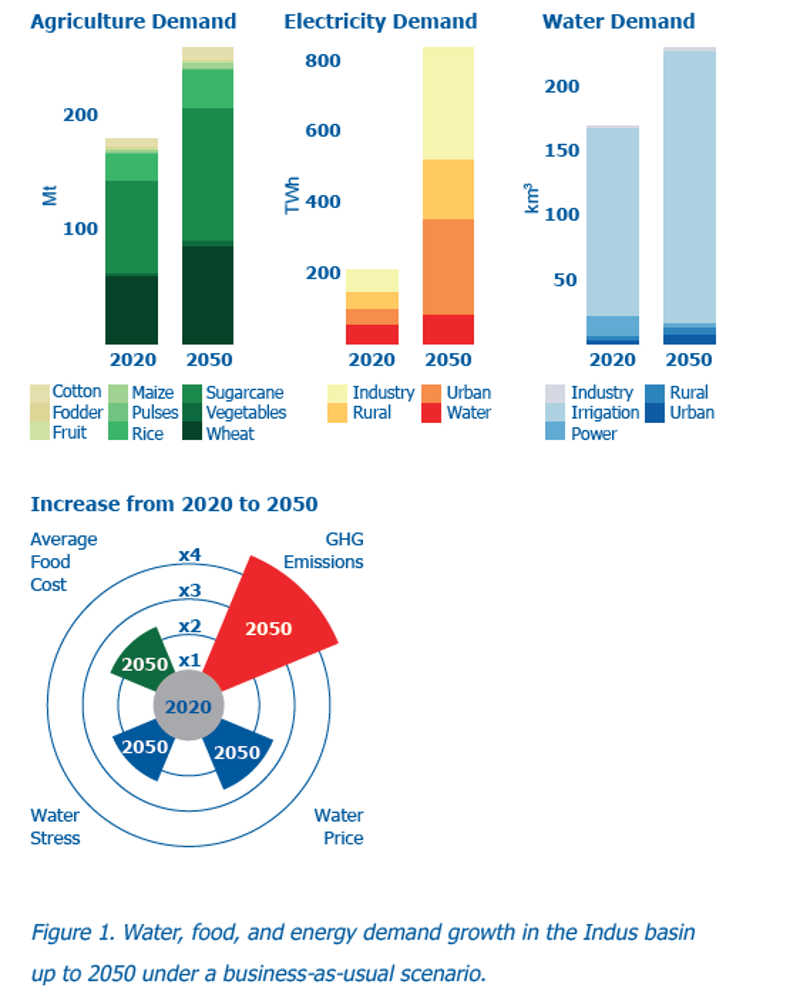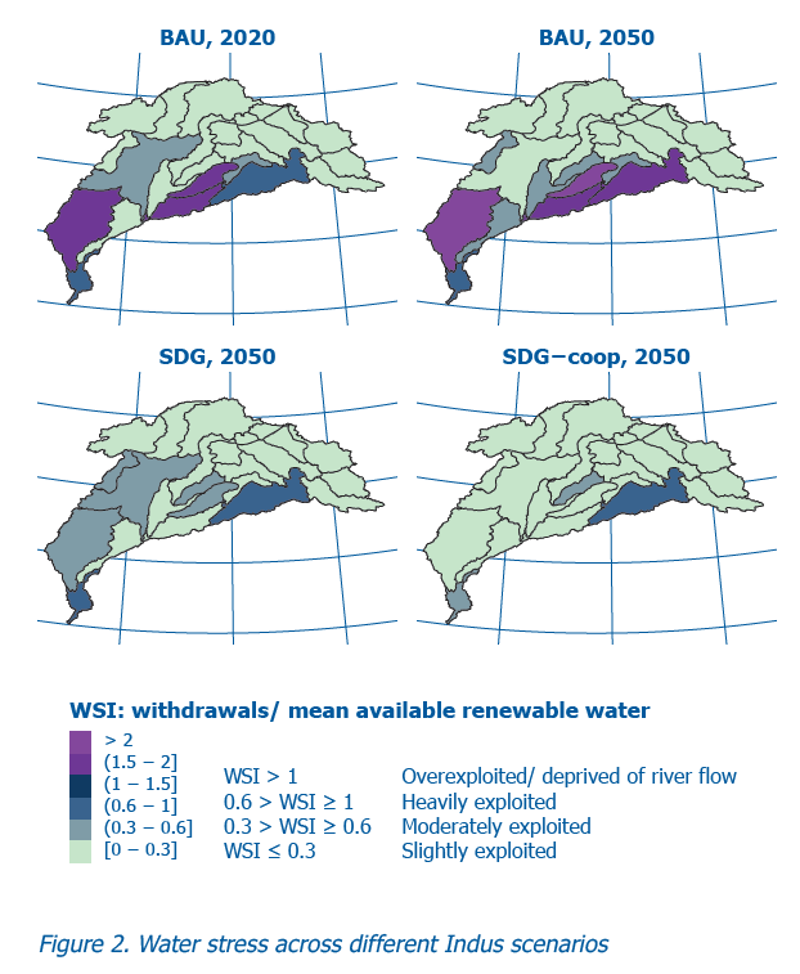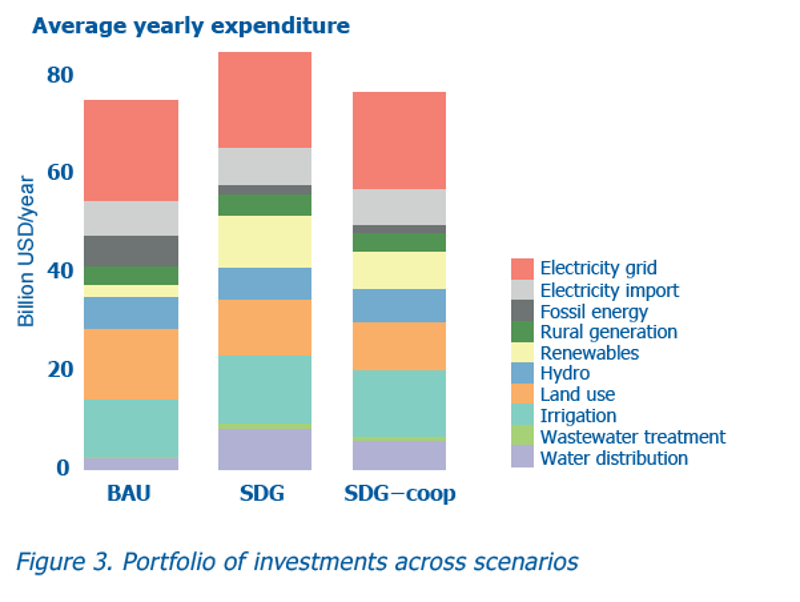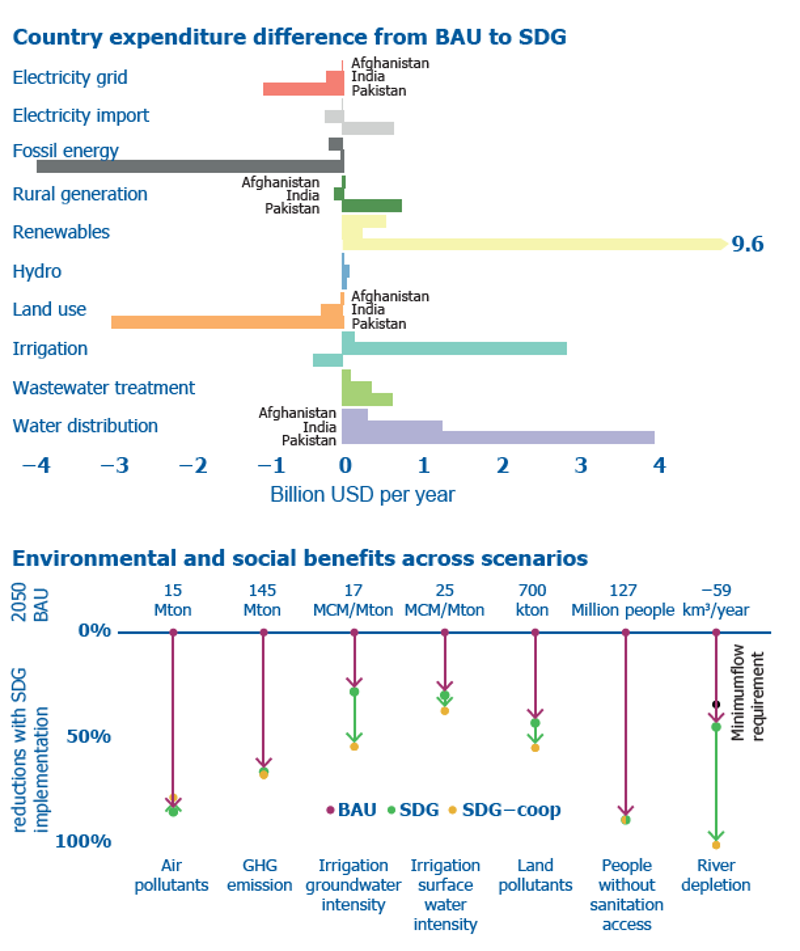
Policy Brief #28, February 2021. Achieving sustainable development in the Indus basin will strongly depend on the capacity of riparian countries to realize the opportunities that arise when cooperation and joint investments across sectors and countries are embraced.
- In the absence of ambitious investments, future water demand will exceed the available water resources of the Indus basin by 2050 and put the system at risk of collapse. The impacts will be particularly acute in the downstream parts of Pakistan.
- Joint water, food, and energy investments can help to meet the basin’s sustainable development agenda by 2050 without increasing water demand and easing existing water stress.
- Pursuing a sustainable development pathway will require annual investments of approximately US$85 billion per year up to 2050. Such investments would be 13% more than what would be required for continuing along a business-as-usual pathway, but social and environmental returns will be larger.
- The distribution of additional investments needed to put the Indus basin on a sustainable development pathway will mostly be borne by Pakistan and India, and to a lesser extent by Afghanistan.
- Overall investment costs could be reduced by up to 9% if riparian countries decided to cooperate and develop joint sustainable investments. Such a strategy will not only reduce the financial burden, but also deliver the greatest social and environmental benefits.
- Cooperation strategies include the promotion of internal trade and the allocation of energy and food production to the regions with the largest comparative advantages.
The challenge ahead
From the lofty peaks of the Himalayas down to the Arabian sea, the Indus river is one of Asia’s longest, with headwaters in Afghanistan, China, and India, and flowing through the length of Pakistan. Its water is integral to supporting local livelihoods and the economy of the region, including the world’s largest irrigation system and an as yet untapped hydropower potential.
The Indus basin is home to around 250 million people of which half work in agriculture. Approximately 110 million people live in extreme poverty (less than US$ 2 per day). Combined with low to moderate levels of access to basic services, healthcare, and education, this means that large parts of the population are vulnerable to climate impacts and have low adaptive capacity. These socioeconomic challenges coupled with rapid population growth will place increasing pressure on the basin’s natural resources.
Riparian countries are implementing numerous development plans to pave the road to a more prosperous future. However, these plans are mostly being developed in isolation, and it remains to be seen how they will unfold together and what the associated cross-sectoral and transboundary impacts will be. While there are different avenues to a sustainable future, strategic decisions would need to be made across different sectors and countries to manage potential trade-offs and maximize the effectiveness and co-benefits of proposed investments.
Alternative development pathways
Different countries in the Indus basin have different values and priorities. Upstream countries like India, are seeking to expand their hydropower potential, whereas downstream users like Pakistan fear the implications such policies might have for their own development plans, given their high dependency on upstream seasonal water flows, low water storage capacity,
and the expected increase in water demand. This development pathway is characterized by siloed planning, limited transboundary cooperation, and a mindset that regards environmental degradation and natural resource exploitation as an inevitable toll that countries have to bear for the sake of socioeconomic development.
In contrast to this business-as-usual pathway, there are emerging views that a more sustainable pathway is possible alongside the realization of the 2030 Agenda for Sustainable Development. The most ambitious of these foresee that countries will greatly benefit from pursuing a sustainable development pathway by promoting cross-sectoral, and most importantly, transboundary cooperation, since such a strategy could help reduce the financial burden and deliver the greatest social and environmental benefits.
Key findings and policy recommendations
Substantial environmental and economic trade-offs
The basin’s population is expected to reach 360 million people by 2050, while GDP will at least double. If riparian countries choose not to deviate from business-as-usual, demands for water, food, and energy will increase, thus exacerbating water stress, increasing greenhouse gas emissions fourfold, and doubling freshwater prices and food costs.
Cooperation and sustainable investments
In a business-as-usual scenario, basin water withdrawals will increase by 18%. The impacts of growing water demands will especially be felt in the middle and lower sections of the basin, such as Punjab (both Indian and Pakistani) and lower Pakistan, which already struggle with water scarcity and will overexploit renewable water sources by up to 250% by 2050. Climate change will further exacerbate this competition as it is likely to reduce water availability in the long run, although further research is needed to discern existing uncertainties linked to expected impacts of climate change on water resources.
Reversing this counterproductive trend and putting the basin on the pathway to meet the water, food and energy Sustainable Development Goals (SDGs) is possible without increasing the demand for water.
In the agricultural sector, this will require investments in irrigation efficiency, limiting overall withdrawals, use of reclaimed waters, and crop relocation measures, which can help to save substantial water and ease competition between irrigation and domestic supply. Further
investments will be needed to improve access to piped water, and wastewater treatment, as well as to improve the operational management of dams to secure environmental flows.
On the energy side, a shift from fossil-fuel based electricity generation to more distributed renewable sources can also ultimately help save water resources and support an ambitious reduction of nationally determined contributions (NDCs). This portfolio of investments will reduce water stress across the basin, and even more so if countries agree to cooperate and
develop joint investments.
Materializing the Sustainable Development Agenda
The sectoral investments needed to materialize the proposed development pathways by 2050 will require equivalent to $75 billion per year for business-as-usual and $85 billion per year under a sustainable development scenario (SDG scenario). The 13% annual increase in investments needed to achieve the Sustainable Development Agenda are largely linked to the expansion of renewable energy access, water treatment, and distribution.
The distribution of the additional investments will largely be shared between Pakistan and India in the amount of approximately $5 billion and $4 billion per year respectively, and to a lesser extent by Afghanistan in the amount of $1 billion per year. Pakistan’s investments
would need to be largely geared towards the energy and water sector, while in India, most efforts will be directed toward expanding and updating water distribution and treatment, and improving irrigation efficiency.
The social and environmental benefits of pursuing a sustainable development pathway will be significant. Water investments will give an additional 130 million people access to sanitation and facilitate the recycling of water for domestic purposes. The shift to renewable energy sources will reduce air pollutants and greenhouse gases by 85% and 65% respectively, and also reduce water consumption for cooling. Additional indirect benefits could also stem from the positive effects decentralized electricity production with solar photovoltaic (PV) or mini-hydro could have in overcoming energy poverty.
Cooperation is key for sustainable development
The total basin costs under a cooperation scenario would require annual investments that are only 2.6% higher than those needed under a business-as-usual scenario. Cooperation and joint investments will also deliver the greatest environmental and efficiency benefits. This will be possible because of the increasing agricultural specialization of the most productive regions combined with food trade policies to address potential gaps. On the energy side, electricity trade based on lower prices does not show great benefits in terms of emissions reductions, but significantly lowers investment costs by partially replacing expensive solar energy production in lower Pakistan with cheaper electricity production from hydropower, geothermal, and solar PV in India. Energy trade will also facilitate meeting the different country demands.
From a water perspective, revising water allocation agreements between countries would save significant investments to redistribute water internally in India to match domestic demand. This strategy would also allow significantly higher inflows to Pakistan, thus reducing water stress in the entire basin.
In summary, policies that pave the way for such cooperation should be pursued even with limited crop shifts that are politically and socially challenging to implement
About this research and the ISWEL project
IIASA led the Integrated Solutions for Water, Energy, and Land (ISWEL) project in partnership with the Global Environment Facility (GEF) and the United Nations Industrial Development Organization (UNIDO). ISWEL received funding from IIASA and GEF (GEF contract Agreement: 6993). The main goal of the project was to develop tools and capacities to support the integrated management of water, energy and land at global and regional scales. The Indus assessment involved 10 researchers from IIASA across the Energy, Water, and Ecosystem Services and Management programs. The work was led by Adriano Vinca ([email protected]) and Simon Parkinson ([email protected]), supervised by Keywan Riahi, and was originally published in Nature Sustainability. This policy brief was written by Barbara Willaarts with supported contributions from the lead authors, Edward Byers, and Ansa Heyl. Project results can be found here.
IIASA Policy Briefs report on research carried out at IIASA and have received only limited review. Views or opinions expressed herein do not necessarily represent those of the institute, its National Member Organizations, or other organizations supporting the work.




